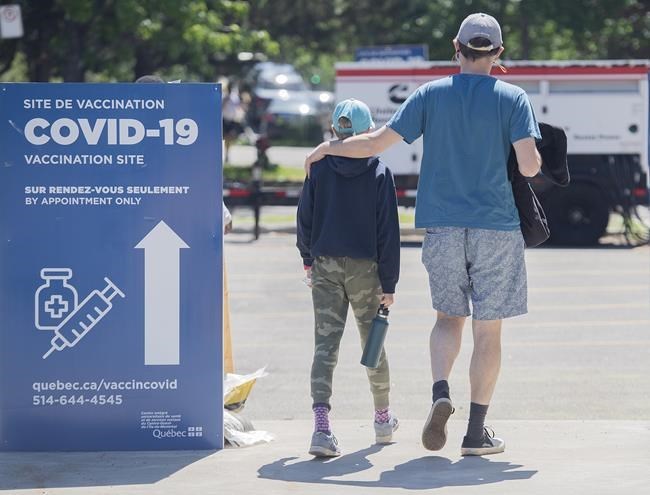TORONTO — More than half of all people in Canada have received their first dose of a COVID-19 vaccine, health authorities reported Wednesday, as Alberta charted an ambitious course to lift most pandemic restrictions by early July.
The Alberta government's "open for summer" plan is possible because residents have "crushed" a spike in COVID-19 cases and are getting vaccinated, Premier Jason Kenney said.
The province's three-stage plan is tied to the percentage of residents aged 12 and older who have received a first shot of vaccine and to hospitalization numbers.
"It's up to Albertans now," Kenney said. "You can do your part … by getting vaccinated as soon as possible."
In all, 20 million people in Canada have now had a shot, close to two-thirds of those aged 12 and older. Children under 12 won't be eligible for several more months.
Canada is now among the top five countries in the world for the percentage of population with at least one dose — ahead of the U.S., according to the website ourworldindata.org. However, it lags well behind the U.S. and other countries when it comes to the number of fully vaccinated people.
Chief Public Health Officer Dr. Theresa Tam wants to see three-quarters of the population fully vaccinated before most restrictions are lifted.
Provinces have already begun easing restrictions, announcing various reopening plans that, like Alberta, depend on vaccination numbers and falling case counts.
As part of its staged reopening plan, Alberta will loosen capacity limits for places of worship to 15 per cent starting Friday, and allow hair salons and restaurant patios to open on Tuesday. Theatres, gyms and indoor dining would be allowed by mid-June.
British Columbia's four-step plan, if all goes well, sets Labour Day as a target for the final stage to begin, and would include allowing live entertainment.
Ontario, which has already eased up on outdoor recreation, is planning a three-stage reopening, beginning middle of next month, while Quebec is aiming to see the province out of its highest alert level on June 7. Quebec is planning to relax restrictions in eight regions as of Monday.
Wednesday's vaccination milestone came as Ontario reported another 135,308 people received a shot.
The vaccination rollout was also making good progress among Indigenous adults, with more than three-quarters now having received at least one dose of COVID-19 vaccine.
Federal Indigenous Services Minister Marc Miller said Indigenous people in Manitoba, which has the country's highest rate of new coronavirus infections, can book second shots. Manitoba said second doses are also available to anyone who received a first dose on or before March 29.
Despite the ongoing vaccination progress, COVID-19 continues to sicken and kill. Ontario, for example, reported 1,095 new cases on Wednesday, and 23 more related deaths. The Ministry of Health said 1,073 people were in hospital because of the disease, with 672 in intensive care and 469 on ventilators.
Quebec reported 308 new cases and another four deaths. COVID-19 patients needing hospital care fell by 16 to 399, although 101 remained in intensive care.
Central Newfoundland and Labrador was coping with a growing outbreak blamed on the emergence of the B.1.617.2 variant first detected in India. Forty-six people are involved in the outbreak, prompting heightened public health restrictions.
One advocacy group called on the federal government to investigate the deaths of migrant farm workers in quarantine and hospital this year. Migrant Workers Alliance for Change said at least five had died between March 13 and April 30.
Also on Wednesday, Auditor General Karen Hogan said the federal government was unable to ensure Indigenous communities and organizations had enough needed nurses and paramedics to deal with the pandemic. Hogan said the epidemic merely exacerbated long-standing shortage.
Another report from Statistics Canada found the pandemic hit women slightly harder than men in terms of employment. The agency said women accounted for 53.7 per cent of year-over-year employment losses from March 2020 to February 2021.
Relatively more women work at small firms in service industries, which, StatCan said, had been hit hardest during the pandemic.
This report by The Canadian Press was first published May 26, 2021.
Colin Perkel, The Canadian Press


